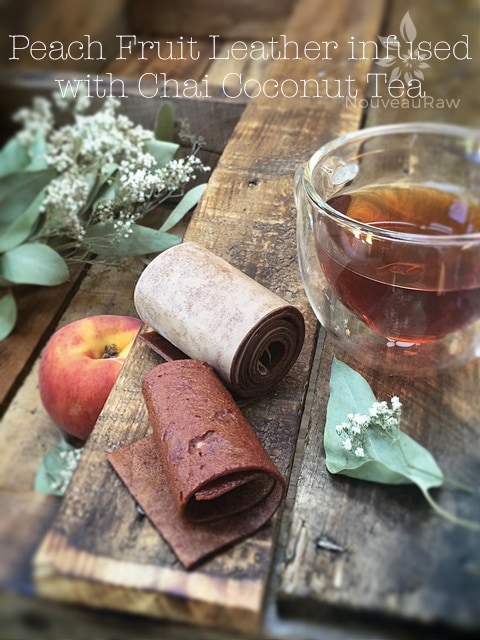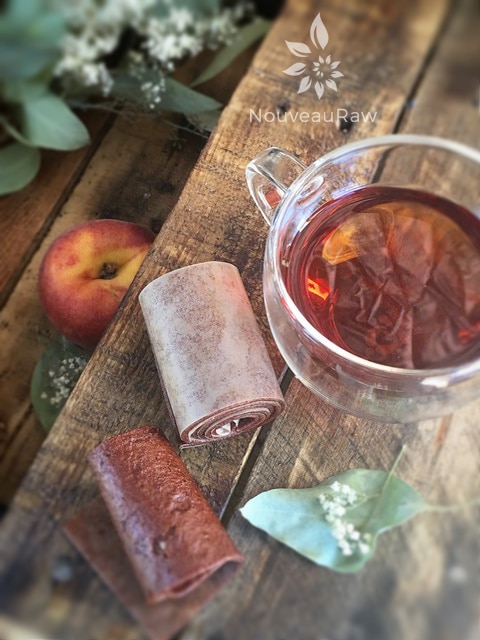Peach Fruit Leather infused with Chai Coconut Tea

 Add to favorites
Add to favorites

~ raw, vegan, gluten-free, nut-free ~
One of my all-time favorite teas is Chai Coconut Tea. I drink it almost daily over ice with a little stevia. So as I was pureeing peaches to make some fruit leather, I decided to get brave and introduce them to one another.
At first, it was just like a blind date, they both sat quietly in each others presence hardly making any contact, but as time moved on, they soon were fused together, mingling and lingering. They are now a couple, a pair, soul mates… and I love them together. :) Who knew!
Ingredients:
yields 4 cups
- 6 cups chopped, organic peaches
- 2 Tbsp chia seeds, ground in spice grinder
- 1 bag of chai coconut tea (contents only)
Preparation:
- Select RIPE or slightly overripe peaches that have reached a peak in color, texture, and flavor.
- Prepare the peaches; wash, dry, remove stems, and stones.
- Puree the fruit, ground chia, and chai tea (pour the actual contents of the tea bag into the puree mix), in the blender or food processor until smooth.
- Taste and sweeten if needed. Keep in mind that flavors will intensify as they dehydrate.
- When adding a sweetener do so a little at a time, and reblend, tasting until it is at the desired taste.
- It is best to use a liquid type sweetener. Don’t use granulated sugar because it tends to change the texture of the finished fruit leather.
 Allow the puree to sit for 10 minutes, so the chia has time to thicken the puree.
Allow the puree to sit for 10 minutes, so the chia has time to thicken the puree.- Spread the fruit puree on teflex sheets that come with your dehydrator. Pour the puree to create an even depth of 1/8 to 1/4 inch. If you don’t have teflex sheets for the trays, you can line your trays with plastic wrap or parchment paper. Do not use wax paper or aluminum foil.
- Lightly coat the food dehydrator plastic sheets or wrap with a cooking spray, I use coconut oil that comes in a spray.
- When spreading the puree on the liner, allow about an inch of space between the mixture and the outside edge. The fruit leather mixture will spread out as it dries, so it needs a little room to allow for this expansion.
- Be sure to spread the puree evenly on your drying tray. When spreading the puree mixture, try tilting and shaking the tray to help it distribute more evenly. Also, it is a good idea to rotate your trays throughout the drying period. This will help assure that the leathers dry evenly.
- Dehydrate the fruit leather at 145 degrees (F) for 1 hour, reduce temp to 115 degrees (F) and continue drying for about 16 (+/-) hours. The finished consistency should be pliable and easy to roll.
- Check for dark spots on top of the fruit leather. If dark spots can be seen it is a sign that the fruit leather is not completely dry.
- Press down on the fruit leather with a finger. If no indentation is visible or if the fruit leather is no longer tacky to the touch, the fruit leather is dry and can be removed from the dehydrator.
- Peel the leather from the dehydrator trays or parchment paper. If the fruit leather peels away easily and holds its shape after peeling, it is dry. If the fruit leather is still sticking or loses its shape after peeling, it needs further drying.
- Under-dried fruit leather will not keep; it will mold. Over-dried fruit leather will become hard and crack, although it will still be edible and will keep for a long time
- Storage: to store the finished fruit leather…
- Allow the leather to cool before wrapping up to avoid moisture from forming, thus giving it a breeding ground for molds.
- Roll them up and wrap tightly with plastic wrap. Click (here) to see photos of how I wrap them.
- Place in an air-tight container, and store in a dry, dark place. (Light will cause the fruit leather to discolor.)
- The fruit leather will keep at room temperature for one month, or in a freezer for up to one year.
Culinary Explanations:
- Why do I start the dehydrator at 145 degrees (F)? Click (here) to learn the reason behind this.
- When working with fresh ingredients, it is important to taste test as you build a recipe. Learn why (here).
- Don’t own a dehydrator? Learn how to use your oven (here). I do however truly believe that it is a worthwhile investment.
© AmieSue.com
Tags: Dairy Free, Gluten Free, Nut Free, Refined Sugar Free, Soy Free, sugar free, Vegan



 Add to favorites
Add to favorites
 Allow the puree to sit for 10 minutes, so the chia has time to thicken the puree.
Allow the puree to sit for 10 minutes, so the chia has time to thicken the puree.
Thanks for the specific directions! Many recipes leave one wondering about the process!!!
I did not know you can consume the actual tea leaves. Can they be used in any cooking adventure?
Thanks!!!
Hi Chris,
Your welcome! I am guessing the tea leaves can be used in most cooking adventures… I have used them in raw cookies, cakes, fruit leathers, and crackers. It would depend on what you are making and just experimenting! Have fun, amie sue
Hello Amie Sue,
If you toss a little Espresso in your cup you’ll
have my new addiction!! Dirty Chai! I still have
not purchased a food dehydrator. I can totally see
this being yummy!!! Thanks Amie Sue for serving up
all this “food mind candy.” :) I think my hips just got bigger.
Hello Gabrielle :)
Dirty Chai…. now that sounds fun! A can see a new recipe “brewing” in the future. lol It is great to hear from you, I hope all is well. :) hugs, amie sue
This sounds delicious! I love the idea of pairing chai tea with peach! I need to try this combination :)!
Amie Sue,
I just wanted to thank you for your site. It’s amazing and everything is presented in such a way that there isn’t a recipe I wouldn’t be willing to try, which is a nice change, believe me. I’m a Raw Newbie and your site has completely altered my definition of ‘Raw’. Thank you!
Carolyn D.
Thank you Carolyn… I hope that you stay inspired as you browse through the recipes. If you need any help, just let me know and I will help you in any way that I can. Blessings, amid sue
Ami-Sue, question, you wrap all your leathers in plastic wrap, I don’t use plastic wrap because of the “chemicals”. It’s wax paper or parchment. Are either of these going to work?? They will definitely not have as tight a seal….or should I just not try, but they all look so good!!!
Good morning Donna.
You can use either wax or parchment but I don’t find that they seal as well. (as you too indicated) How about wrapping them in parchment and then store in a 1/2 gallon mason jars (since it is tall)? That will help keep some air out. Let me know what you think. Blessings, amie sue